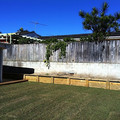Gallery
Click the thumbnails below to view image gallery:In the case of gardening, there will be instances when you must move your palms in the ground. The reasons are plenty. You may need to make more space; you may need to improve the spacing between them for better growth or you have just decided that it is more aesthetically pleasing that way. Whatever your reason for transplanting your palm, you must follow some basic instructions.
Luckily palms are one of the easiest plants to move because of their large and fibrous root ball as opposed to trees with long taproots. They are compact and may be lifted out like a ball. The palms are also known for recovering quickly after a move.
During the growing season is the best time. Take as much soil as possible around the root ball. Some palms will not survive moving such as the Bisimarkia's and Bangalow's. Alexandra's are good to move along with Windmills, Golden Canes and Triangles.
Consider the location where you will be moving your palm
Take into consideration the size the palm might grow into and if the view will be compromised.
Prune any damaged or worn out fronds and water the palm's roots thoroughly right before you plan the move.
Start digging a trench around the palm
Once the trench is deep enough, dig out as large a root ball as you can manage. Push the plant gently until it has tipped over. With the help of a crowbar and shovel, pry out the rest of its root system until you get it completely out of the hole. It is inevitable to cut into some of the roots.
You may need up to three or four people to help you lift out the palm from the hole depending on the size. It will be handy to have a wheelbarrow or a cart for easy transportation. If the palm is large and you have the money, employ a small or large excavator.
Wrap the roots of your Palm
If the transplanted palm involves moving via a vehicle, it is important to wrap the roots in hessian cloth. Spray the hessian with water to ensure that the roots stay most while in transit. Bring together all the palm fronds and wrap them together using twine.
Water the hole well
Before planting the palm into its new location, make sure that the new hole is watered. Place the palm into the hole at the same depth as it was growing before. Add water to the hole after you have planted it. Then pack soil around the palm tightly. If the palm is tall (4 metres or more) tie up the fronds around the palm trunk when re planting the palm. Leave them tied for a couple weeks after re planting. This will reduce transpiration and reduce the palm moving in the wind. The palm's roots need to re connect and grow back into the soil. To also assist with root re growth , compact the soil around the base of the re planted palm. Even better with large and expensive palms use a commercial soil compactor to compress the soil. Establish a drip watering system at the base of the palm and leave it running for the first couple weeks.
Build a stake using three posts to keep the tree in place and secure
You can use metal star pickets or stakes made out of timber. Use your hessian tape to keep them in place.
Keep the soil moist
Remember to water daily to keep the soil moist and to help its roots establish themselves in their new location. Water the roots with a seaweed solution this will help promote root development. It will take about three weeks before you can cut down on watering to about twice or thrice a week depending on the temperature. Once you have stabilized your palm into its new place, you may begin to fertilize.
<< Previous Understanding the Nature of Triangle Palm for Beginners | Back to Mullumbimby Palm Blog | Next >> Ways to Enforce Weed Control and Keep Your Palm Safe






